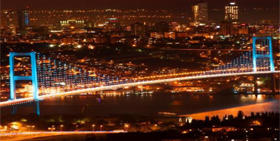Panorama Country - Turkey: What to expect in 2014?

The Turkish economy experienced remarkable growth within the last decade. The country’s gross domestic product nearly tripled during this period and reached 820 billion USD at the end of 2013. The country has a population of 76.7 million people and a per capita income of around 10,700 USD. According to the IMF, on a purchasing power parity basis Turkey is now the 16th largest economy in the world and the 6th largest in Europe. The government’s GDP per capita target for 2023 is 25,000 USD.
After recording high growth rates in the post-crisis period, Turkish economy managed to negotiate a soft landing in 2012 which helped reduce the imbalances in the economy. The authorities were able to reduce the current account deficit from alarming levels, soften inflationary pressures while total employment continued to increase.
However the import dependence of the manufacturing industries still represents a structural weakness. Lower growth rate will affect negatively corporate profits in 2014. Our sector barometer which reveals financial performance of companies in different industries coupled with Coface payment experience, indicates risks are rising for the corporate sector. Especially companies which don’t have export earnings or have a fragile capital structure would suffer from slower growth, weaker currency and higher production costs. This would reduce the profit margins which in return would increase the risk of bankruptcies.
Recent developments in Turkish economy
Moderate growth, narrower external deficit…
After the soft landing in 2012, the Turkish economic growth accelerated in 2013 on the back of domestic demand, especially strong household consumption expenditures and public spending. The economy posted a faster-then-expected growth of 4 percent in 2013,above the government expectation of 3.6 percent in the medium term plan despite the tapering of the global liquidity, political uncertainties and high interest rates.
The total local demand contributed 6.4 percentage points to the growth in 2013, up from-1.9 in 2012.
The contribution from public and private consumption expenditures stood at 3.7 percentage points. The contribution of total investment was weaker and stood at1.1 percentage points. However, the contribution of the net exports was negativedue to the strong domestic demand and high gold importsduring the year. The net exports dragged down the growth rate by 2.3 percentage points in 2013 as a whole.
Industrial developments
Automotive sector: drop in domestic sales, focus on exports
The automotive industry is a sector of primary importance for the Turkish economy. The industry has prospered since 1960’s and became export oriented and competitive after 1990’s with the arrival of global car makers. Turkey has become a re-export hub for big automotive producers of the world as these companies have started to build factories in the country, usually alongside a local partner.
Total production increased considerably in recent years. According to OICA statistics, Turkey has become 16th biggest motor vehicle producer in 2012 with a total production of 1,072,339 units, which was 9.8 percent lower from a year ago. The country was ranked 17th producer in the world production in 2011.
Textile and clothing sectors: Advantage of the local currency weakness and the European recovery
The textile, clothing and leather industries are considered among the strategic sectors by the Turkish government to reach the country’s target of 500 billion USD by 2023. Three industries account forapproximately 16 percent of the totalvalue-added in the manufacturing sector and 10 percent of the national output, according to the Ministry of Industry. The annual value of production of the three industries reached 48.6 billion USD in 2012, providing nearly 12 percent of the total employment including informal labor.
The competition in the textile industry around the world intensified after the elimination of quotas on China’s textile and clothing exports in 2005. Turkey still ranks among the biggest global players in these industries asit offers low production costs, fast delivery times due to geographical proximity to the European markets, strong knowledge and a massive production expertise. Turkey’s share in the world textile exports stood at 3.9 percent in 2012, according to the World Trade Organization data while its share in the world clothing exports was 3.4 percent.
Construction sector: Slower demand for housing
The construction sector has been one of the driving forces of Turkey’s economy. Many other sub-sectors are in close relation with the construction sector like cement, concrete, ready-mixed concrete, ironand steel industry, ceramic, glass and brick industries.
Sector barometer
Metal
The metal sector (except iron and steel) in Turkey presents very high risks.
The fall in raw material prices and the currency risk deteriorate the cash flow for some companies. Specifically, the profitability falls for the companies having debt denominated in foreign currency and a weak capital structure, which creates financial pressures for these companies.
Food
The food sector in Turkey presents medium risks.
The food industry is one of the most important sectors in Turkey. Foreign direct investments totaled 343 million USD in 2013. Turkey had a trade surplus of 5 billion USD from food and beverage exports and imports in 2013. Main challenge for food producers will the rise of production costs due to the drought. Another risk would be the difficulties in cash management due to the longer maturity of payments from hypermarkets. However there is no major risk that would threaten the activities of companies in this sector.
Chemical
The chemicals sector in Turkey presents high risks.
Turkey aims to reach 50 billion USD in chemical exports by 2023. In 2013 Turkish exports of chemicals reached 7.6 billion USD, compared with 7.3 billion USD in 2012. The exports of rubber and plastic products rose from 6.4 billion USD to 7 billion USD at that time. Turkey’s plastic sector is the third largest in Europe with an annual production of 7.2 million tons of plastics. The major risk comes from the heavy dependence on imports. The rising borrowing costs due to the rise in interest ratesand the slowdown in domestic housingsector, home appliancesand car markets also create risks on the demand side.
Kontakt
Saša MAROTTI
Head of Sales and Marketing
Avenija Dubrovnik 46
10000 Zagreb
CROATIA
Tel: +385 1 4697 510
mail: sasa.marotti@coface.com


